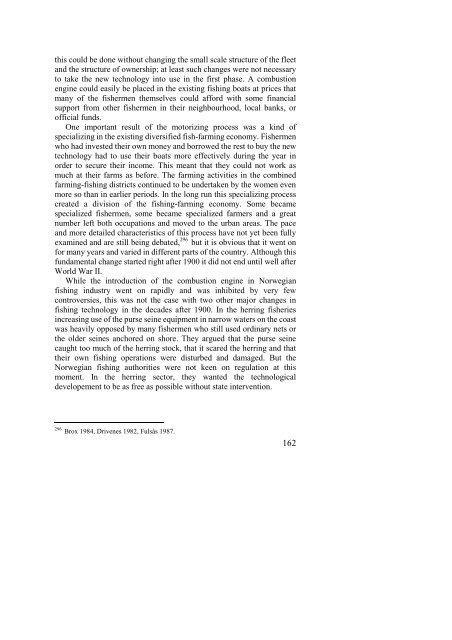The North Atlantic Fisheries, 1100-1976 - University of Hull
The North Atlantic Fisheries, 1100-1976 - University of Hull
The North Atlantic Fisheries, 1100-1976 - University of Hull
You also want an ePaper? Increase the reach of your titles
YUMPU automatically turns print PDFs into web optimized ePapers that Google loves.
this could be done without changing the small scale structure <strong>of</strong> the fleet<br />
and the structure <strong>of</strong> ownership; at least such changes were not necessary<br />
to take the new technology into use in the first phase. A combustion<br />
engine could easily be placed in the existing fishing boats at prices that<br />
many <strong>of</strong> the fishermen themselves could afford with some financial<br />
support from other fishermen in their neighbourhood, local banks, or<br />
<strong>of</strong>ficial funds.<br />
One important result <strong>of</strong> the motorizing process was a kind <strong>of</strong><br />
specializing in the existing diversified fish-farming economy. Fishermen<br />
who had invested their own money and borrowed the rest to buy the new<br />
technology had to use their boats more effectively during the year in<br />
order to secure their income. This meant that they could not work as<br />
much at their farms as before. <strong>The</strong> farming activities in the combined<br />
farming-fishing districts continued to be undertaken by the women even<br />
more so than in earlier periods. In the long run this specializing process<br />
created a division <strong>of</strong> the fishing-farming economy. Some became<br />
specialized fishermen, some became specialized farmers and a great<br />
number left both occupations and moved to the urban areas. <strong>The</strong> pace<br />
and more detailed characteristics <strong>of</strong> this process have not yet been fully<br />
examined and are still being debated, 296 but it is obvious that it went on<br />
for many years and varied in different parts <strong>of</strong> the country. Although this<br />
fundamental change started right after 1900 it did not end until well after<br />
World War II.<br />
While the introduction <strong>of</strong> the combustion engine in Norwegian<br />
fishing industry went on rapidly and was inhibited by very few<br />
controversies, this was not the case with two other major changes in<br />
fishing technology in the decades after 1900. In the herring fisheries<br />
increasing use <strong>of</strong> the purse seine equipment in narrow waters on the coast<br />
was heavily opposed by many fishermen who still used ordinary nets or<br />
the older seines anchored on shore. <strong>The</strong>y argued that the purse seine<br />
caught too much <strong>of</strong> the herring stock, that it scared the herring and that<br />
their own fishing operations were disturbed and damaged. But the<br />
Norwegian fishing authorities were not keen on regulation at this<br />
moment. In the herring sector, they wanted the technological<br />
developement to be as free as possible without state intervention.<br />
296 Brox 1984, Drivenes 1982, Fulsås 1987.<br />
162















